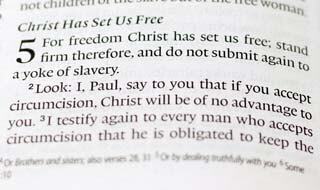Identity is an essential aspect of our self image. In our post Christian society the belief in no absolute truth has allowed our culture to drift into extreme confusion and subjectivity. An example of the escalation in gender identity controversy is an Internet article posted this year that is titled “81 Types of Genders & Gender Identities (A to Z List).”
The Heritage Foundation published a helpful introduction to clarify the concepts that are integral to this subject: sex, gender, and gender identity:
“The best biology, psychology, and philosophy all support an understanding that sex is a bodily reality and that gender is a social manifestation of bodily sex. By contrast, ‘gender identity’ is an internal sense of gender.
Sex is a biological reality, referring to an organism’s overall organization towards sexual reproduction. … It’s the only way to make sense of the concepts of male and female.
Gender, by contrast, is the way one expresses their biological sex.
…Transgender activists deny that sex is a bodily reality. They argue that one’s perceived gender identity represents who a person really is even if it goes against their biological sex. They deny biological reality by suggesting that biological sex was merely “assigned at birth.”
Gender identity: According to the American Psychological Association, ‘Gender identity refers to a person’s internal sense of being male, female or something else.’ It is distinct from either sex or gender. Activists claim it is a person’s ‘internal sense of gender.’ They also assert that it’s more than just male or female; it’s fluid and there is a spectrum of various options beyond man and woman, like ‘gender fluid,’ ‘intergender,’ or ‘non-binary.’ “[1]
As it is useful to distinguish some basic terminology related to sex and gender, it is important to be precise concerning different facets of one’s identity.
1.We have a human identity as those created by God in His image (Gen. 1:26; Psalm 8), although the image has been damaged (Gen. 3).
2. We have a biological (sexual) identity as male or female (Gen. 1:27).
3. Our psychological identity has been shaped by positive and negative life experiences. Over the years we differentiate ourselves from others in the context of social interaction with family and friends. (Compare Matthew 16:13-17, as presented in GFI’s Exchanged Life Conference, session 1.) Our psychological identity is affected by our unique version of the flesh…and is subject to change. Gender identity is an aspect of psychological identity. [2]
4. Spiritual identity: Our essential, ultimate identity is spiritual. If we have been regenerated try God’s Spirit through redemption, then we have a new, grace-based, secure, positive and unchangeable identity in Jesus Christ! (1 John 3:1-3).
To have true wisdom about gender identity issues, we need to maintain a biblical worldview. Sue Bohlin of Probe Ministries affirms,
“That’s the key: we need to understand that this is really a worldview issue. Perspective is crucial. Where you start makes all the difference. If you leave God out of it, starting with the person trying to make sense of the feeling that one’s body is not aligned with their internal sense of gender, then confusion is inevitable. If people feel free to define themselves as they wish, then sex and gender can be seen as elastic or fluid—and manipulatable. It’s the modern-day expression of an Old Testament phenomenon that never worked out well, when ‘every man did what was right in his own eyes’ in the times of the Judges (Judges 17:6).” [3]
In his important book about how to Biblically navigate our gender-confused culture, Gary Yagel counsels parents to wisely address gender identity issues with their children. He summarizes “components of the biblical sexual identity script your teen needs”:
1. It must be rooted in gospel grace, so teens need know that the community to which they belong is the church, the Body of Christ…
2. It recognizes that as believers, their truest identity is to be in Christ and, through Him, the adopted children of God.
3. It explains why they don’t fit into the secular world around them.
4. It emphasizes that they are uniquely designed by God.
5. It motivates boys to pursue godly manhood and girls to pursue godly womanhood.[4]
As Yagel mentioned in point two (above), a key aspect in finding peace and joy is living according to our spiritual identity in Christ.
Although this is our birthright, most believers have not appropriated this new identity. But appropriating our spiritual identity is more than learning about it. Identity flows from identification with Christ (Gal. 2:20; 2 Cor. 5:17). And the Cross of Christ is central to this message and process. The deeper meaning of the Cross is explained in Romans chapters 5,6 and 8.
May we have God’s love and wisdom as we disciple and counsel in a gender-confused culture. James 3:17,18 describes the unchanging wisdom that is from our Creator: “But the wisdom that is from above is first pure, then peaceable, gentle, willing to yield, full of mercy and good fruits, without partiality and without hypocrisy. Now the fruit of righteousness is sown in peace by those who make peace.”
[1] https://www.heritage.org/gender-identity/1-what-are-sex-gender-and-gender-identity
[2] Subjective “gender” first emerged in the humanities wing of secular universities in the 1970’s.
[3] Sue Bohlin, “Transgender Children” https://probe.org/transgender-children/
[4] Gary Yagel, Anchoring Your Child to God’s Truth in a Gender Confused World (Fort Lauderdale, FL: D. James Kennedy Ministries, 2018). 75-77
Copyright © 2022 by John B. Woodward. Permission is granted to reprint this article in its entirety for non-commercial use with credit given. Biblical quotations are from the New King James Version, Copyright © 1982 by Thomas Nelson.

















